1944 ARTICLE: One brisk day back in October, a dapper, broad-shouldered young man made his way across the Washington National Airport to a toy-like little ship, followed by more than one pair of skeptical eyes.
Still in his twenties, with a jaunty homburg slanted back on his head, the fledgling pilot looked more like a gridiron husky than one of the 20 crack engineers in America who understand helicopters from the ground up. The military and civilian observers awaited the demonstration of this latest cloud-hopping jeep, with mixed feelings.
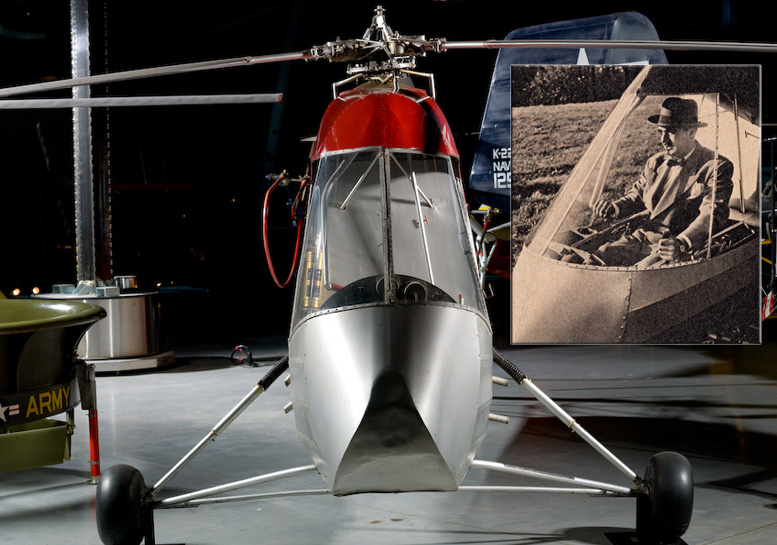
Front view of the PV’s controls, showing extreme simplicity of design. Piasecki’s left and grasps throttle.
As the assembled experts well knew, helicopter flying isn’t child’s play. It taxes the pilot’s nervous system severely. Young Frank Piasecki, far from being a veteran air man, had to his credit a meager 14 hours in a Taylor cub, just enough to entitle him to a student permit.
Worse yet, he had chalked up a mere 16 hours of flying time in helicopters, and was the first American to be granted a helicopter license without first qualifying for the regular airplane pilot’s license. Under the circumstances, this test was doubly important.
There would be no old hand at the controls of the new ship to cope with a wobbly stick, vibrations, or any other defeat which might pop up under the stresses and strains of flight. If the PV-2 turned in a good performance with such a novice in the cockpit it would speak volumes for the safety and controllability of the new flying wind mill.
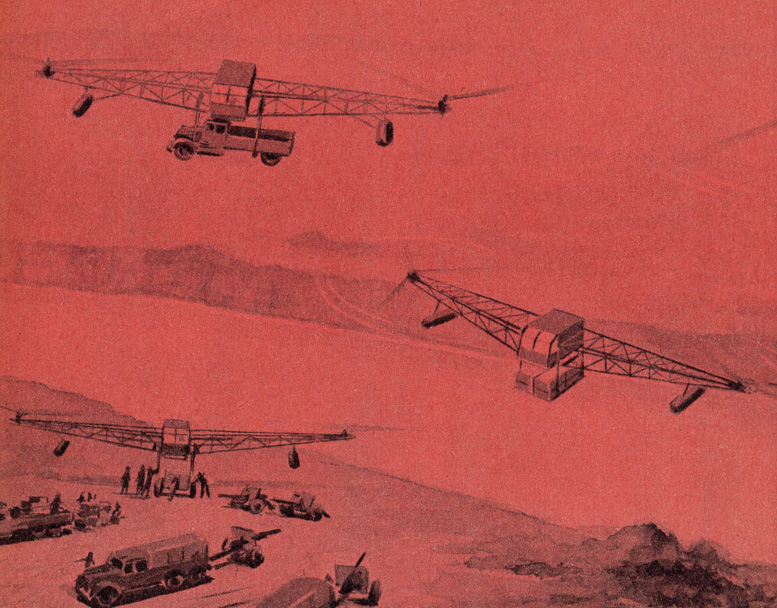
In his research, Piasecki, PV designer, unearthed reports that Germans were using oversize helicopters to carry guns and other equipment across unfordable streams, as shown in the artist’s conception by Mi’s
Fred Ripperda, above.
The experts watched Piasecki climb into the absurd, flimsy-looking little ship with misgivings. How would such a fragile dwarf of a ship, newcomer among rotary-wing machines, fare in the hands of this cocky amateur?
The ship itself was a gawky affair, tiny and compact, looking like a hunched bumblebee poised for the takeoff. Like the Sikorsky model, it was equipped with a main horizontal rotor overhead and a smaller auxiliary rotor attached sideways to the tail, but it looked much lighter, smaller and infinitely less substantial than the VS-300. What it would do in the air was anybody’s guess.
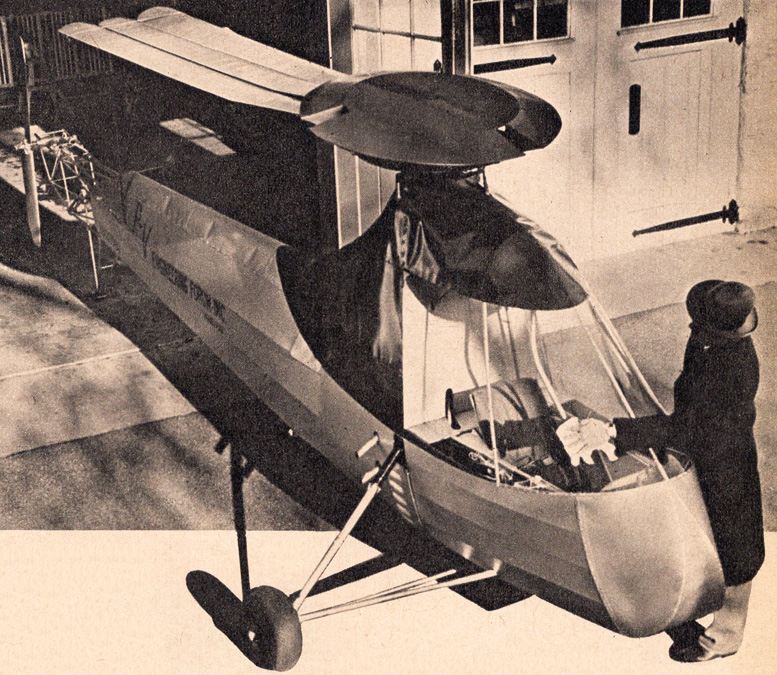
First ship of its kind, the PV helicopter’s rotors fold up so that it will fit into any garage.
There was no cause for alarm. Once Piasecki had slipped into the cockpit of the single seater, the rotors began to hum with an angry whir and the machine rose vertically. It hovered a few feet off the ground, climbed higher and turned smartly in its own length, with the absurd assurance of a circus midget.
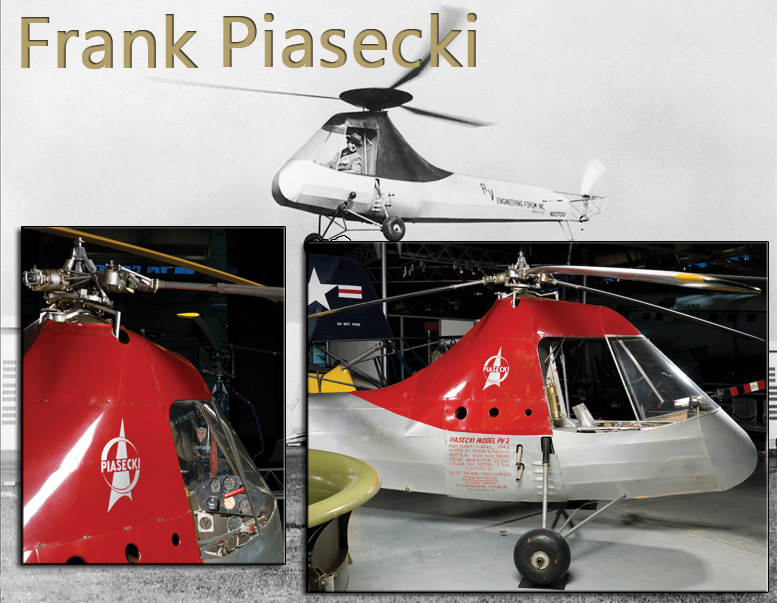
With the ease of an old campaigner Piasecki flew forward at a good clip, backed up, banked, turned sideways and descended vertically to hover again while the news photographers clicked their shutters. The old-timers in the audience sat up and took notice. The demonstration had gone like clockwork.
Later, with the same good-natured non chalance, the young designer took off from a private driveway in Falls Church, Va., and buzzed down the street to a gas station. There he waved three fingers to an attendant, who filled up the gas tank and wiped off the wind shield.
Taking off again, Piasecki flew to a nearby golf club, landed at the first hole, and proceeded to tee off with his waiting friends, much to the delight of the newsreel camera men who trailed along to record the feat. “I just wanted to show it could be done,” Piasecki explained later with a grin. “There’s been a lot of talk lately about how you can land in tight places with a ’copter, but no body’s got around to actually doing it. I thought you fellows might like to see that it’s more than high-powered talk.”
The gas-station clearance in which he had landed was so laid out, with a treacherous two-foot fence enclosing it, that hardly more than 25 square feet were available to Piasecki when he inched his way in. Both ship and pilot, despite their tender years, had turned in a performance as smooth as silk.
Although there are upwards of 26 rotary-wing aircraft projects now on the boards or under construction in this country, Piasecki’s PV-2 is the second helicopter to get into the air for a full-fledged, all-out demonstration spin.
First ship of its type to be fully stream-lined (it was styled by Harry S. Pack, helicopter expert for Pennsylvania Central Air lines), it has a gross weight, including pilot and fuel load, of only 1,000 pounds, and in storage, with the three blades of its 25-foot main rotor folded back, it is only 22 feet four inches long, seven feet seven inches high, and eight feet wide.

Main rotor blades hit a tip speed of about 350 miles per hour; the ship has a landing speed of zero, can cruise at 85 miles per hour and back up at 20 miles per hour. When it is traveling at a forward speed of 50 miles per hour, the PV-2 will climb at a rate of 1,000 feet per minute, which is about as fast as the ascent of a Taylor cub.
If forward speed is eliminated to make the climb directly vertical, the rate is about 600 to 700 feet per minute. This lilliputian single-seater, even as it stands now, is more indicative of the postwar low-cost helicopter than any other model thus far revealed to the public.
In its present form it is a finished vehicle, looking very much like the aerial counterpart of the sport coupe — the Model T of the skyways. With only slight alteration of its dimensions, including some added area to the rotor disc, and a little stepping up of power, the craft can easily be designed to accommodate two, three, or four passengers. The PV midget is the closest thing to a sky-riding runabout that we’ve seen yet.
In its main features the PVs mechanism resembles that of the Sikorsky and other models of orthodox two-rotor design. But, while lift and control principles are conventional, new design details simplify the mechanics of operation and make the craft extremely easy to handle.
On the pilot’s left, over in a corner, is a ratchet lever, something like an emergency brake in appearance, which controls the “total pitch” of the main rotor’s blades — the constant pitch at which all the blades make the complete revolution. The pilot can either operate the throttle in dependently or adjust it to work automatically with the total-pitch lever, as he prefers.
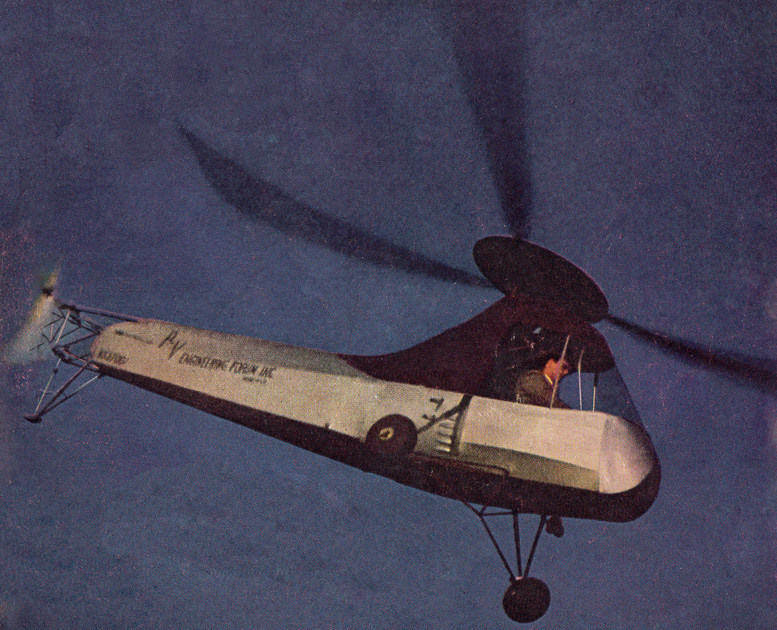
On the other hand, “cyclic pitch” — the pitch of each individual blade, which can be varied in different phases of the revolution, imparting a dip to the fuselage in one phase and a lift in the opposite phase—is adjusted by the main control stick, a long rod which curves down vertically from over head.
This stick is pushed in whatever direction the pilot wishes to travel: forward to go ahead, sideways for movement to right or left, and backward for movement to the rear. All this stick really does is to make the blades bite deeply into the air in one phase, lifting the craft on that side, and bite shallowly in the opposite phase, depressing the body on that side.
Movement will follow in the direction of the tilt. With an over head stick, rather than one that comes up between the pilot’s knees from a slot in the floor, there is more room in the cockpit and it is easier to keep clean.
So carefully has the rotor been designed, with its blades balanced exactly against each other as well as absolutely, that there is no vibration or wobble in the control stick, and a minimum of strain is imposed on the pilot.
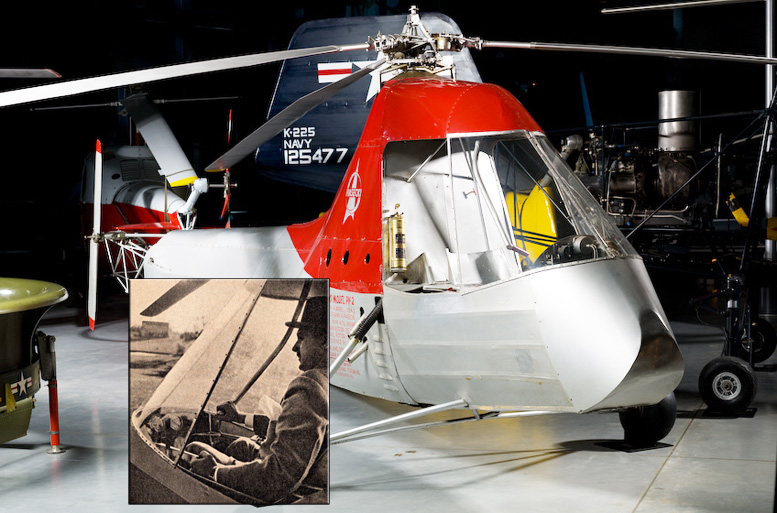
A closeup of the rotor control, in Piasecki’s right hand. The ship goes in any direction the lever is moved.
It is because of this ease in control, cutting nervous effort down to next to nothing, that a novice like Piasecki could fly the PV without prior helicopter experience. As a matter of fact, Piasecki can boast that he test flew his ship back in March at the same time that he was learning to fly any kind of helicopter.
Rudder action in the craft is supplied by a five-foot torque propeller, which is shaft-driven, where as the Sikorsky rear rotor is turned by a belt-drive. As in all helicopters of this type, the auxiliary rotor is necessary to offset the torque or twisting effect of the main rotor, which, if not counteracted, would swing the fuselage in circles in a direction opposite to that of the main rotor’s blades.
The De Bothezat co-axial helicopter meets this problem by having two main rotors mounted on the same axis, one above the other, revolving in opposite directions at the same speed so that their torque effects are cancelled out. When movement directly forward or backward is desired, the blades of the rear prop are pitched, or “feathered,” by the foot rudder bars just enough to cancel out the torque effect of the main rotor.
As a result, there is no turning motion, and the ship goes straight ahead or backwards, depending on whether the control stick is moved forward or back. When movement to one side is desired, the control stick is pushed in that direction and the appropriate foot rudder bar is pressed down—left for left, right for right.
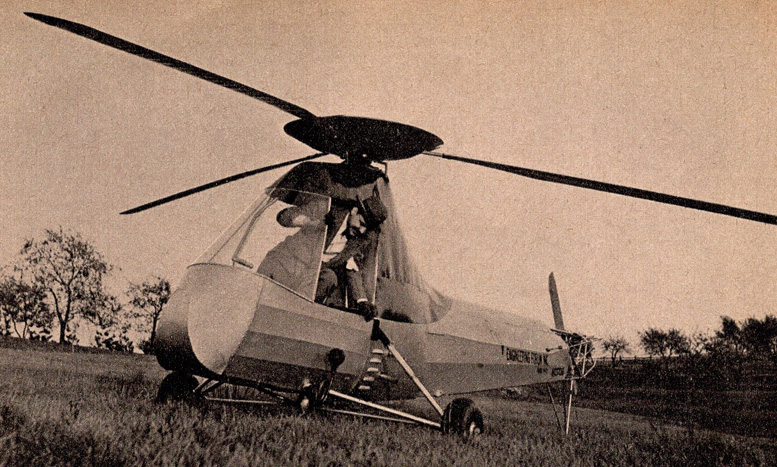
The Franklin four-cylinder, air-cooled engine used in the PV-2 is a 90-horsepower job, of the 180-degree opposed flat type. This engine is mounted with its crankshaft upright just rearward of the cockpit. In order to stand the engine on end, Piasecki and his engineering staff had to work out a special oil scavenge pump under the engine.
To cope with the reduction gear problem, Franklin and Lycoming are said to be working right now on a vertical engine specifically for helicopters. Although most of the design features which reduce vibration in the PV and simplify its controls are secret, it has been revealed that the movement of the engine in its rubber mounting is absorbed by a universal joint placed in the drive shaft between the rotor hub and the gear take-off.
About five percent of the engine’s power is consumed by the centrifugal cooling blower mounted around the clutch assembly—blower cooling is essential, since the craft eats up full power for sizable periods even when standing still.
At present the PV has a ceiling of 5,000 feet and can hit a top speed of 90 do 100 miles per hour, but Piasecki is confident that these limits can be raised without much trouble. “We haven’t been worrying about speed and ceiling,” he says.
“What we wanted to do from, the beginning was to simplify the controls and increase the safety factors. By spending ten times the usual engineering time on each design detail, we’ve pretty well licked the problems we set out to tackle. Later on, when the problems come up, we can fool around with speed, ceiling, passenger capacity, and special automatic safety devices.”
The thoroughness of Piasecki’s engineering is indicated by the fact that the PV has flown successfully, without anything but routine detail changes, since it first took to the air last March.
Piasecki doesn’t claim any radical innovations of a general nature—his machine, like most others utilizes the tried-and-true torque reaction method developed by Von Baumhauer. But his real contribution is a remarkably simplified control.
Movement in any direction is obtained by simply moving the control stick in that direction, and the machine can be tilted or rolled on its own axis without any translation. And what is unique is that the time lapse between the stick’s motion and the resultant motion in the machine is very much shorter than in previous control systems.
This contribution will be a real boom to postwar helicopters, since it makes piloting immeasurably easier. The operator, instead of having to anticipate a control motion — which requires laborious practice in timing before he gets his reactions right — now can get an immediate response from any movement of the stick. This innovation brings the helicopter one giant step nearer the capacities of the average man.
Today Piasecki is still wrapped up in wartime oldtimers in the audience sat up and took notice. The demonstration had gone like clockword. Later, with the same good-natured non chalance, the young designer took off from a private driveway in Falls Church, Va., and buzzed down the street to a gas station. There he waved three fingers to an attendant, who filled up the gas tank and wiped off the wind shield.
Taking off again, Piasecki flew to a nearby golf club, landed at the first hole, and proceeded to tee off with his waiting friends, much to the delight of the newsreel camera men who trailed along to record the feat. “I just wanted to show it could be done,” Piasecki explained later with a grin. “There’s been a lot of talk lately about how you can land in tight places with a ’copter, but no body’s got around to actually doing it. I thought you fellows might like to see that it’s more than high-powered talk.”
The gas-station clearance in which he had landed was so laid out, with a treacherous two-foot fence enclosing it, that hardly more than 25 square feet were available to Piasecki when he inched his way in. Both ship and pilot, despite their tender years, had turned in a performance as smooth as silk.
Although there are upwards of 26 rotary- wing aircraft projects now on the boards or under construction in this country, Piasecki’s PV-2 is the second helicopter to get into the air for a full-fledged, all-out demonstration spin.
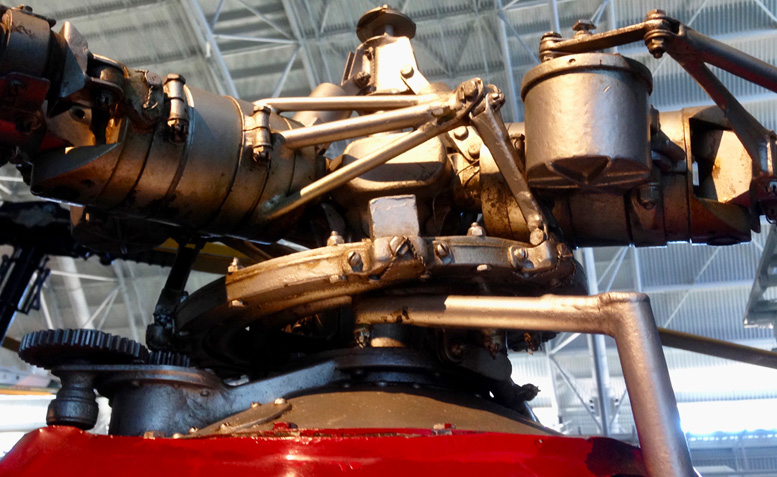
First ship of its type to be fully stream-lined (it was styled by Harry S. Pack, helicopter expert for Pennsylvania Central Air lines), it has a gross weight, including pilot and fuel load, of only 1,000 pounds, and in storage, with the three blades of its 25-foot main rotor folded back, it is only 22 feet four inches long, seven feet seven inches high, and eight feet wide.
Main rotor blades hit a tip speed of about 350 miles per hour; the ship has a landing speed of zero, can cruise at 85 miles per hour and back up at 20 miles per hour. When it is traveling at a forward speed of 50 miles per hour, the PV-2 will climb at a rate of 1,000 feet per minute, which is about as fast as the ascent of a Taylor cub. If forward speed is eliminated to make the climb directly vertical, the rate is about 600 to 700 feet per minute.
This lilliputian single-seater, even as it stands now, is more indicative of the postwar low-cost helicopter than any other model thus far revealed to the public. In its present form it is a finished vehicle, looking very much like the aerial counterpart of the sport coupe — the Model T of the skyways.
With only slight alteration of its dimensions, including some added area to the rotor disc, and a little stepping up of power, the craft can easily be designed to accommodate two, three, or four passengers. The PV midget is the closest thing to a sky-riding runabout that we’ve seen yet.
In its main features the PVs mechanism resembles that of the Sikorsky and other problems. He is convinced that the Germans have been going places with military helicopters, and he emphasizes the urgent necessity to keep ahead of them in this field.
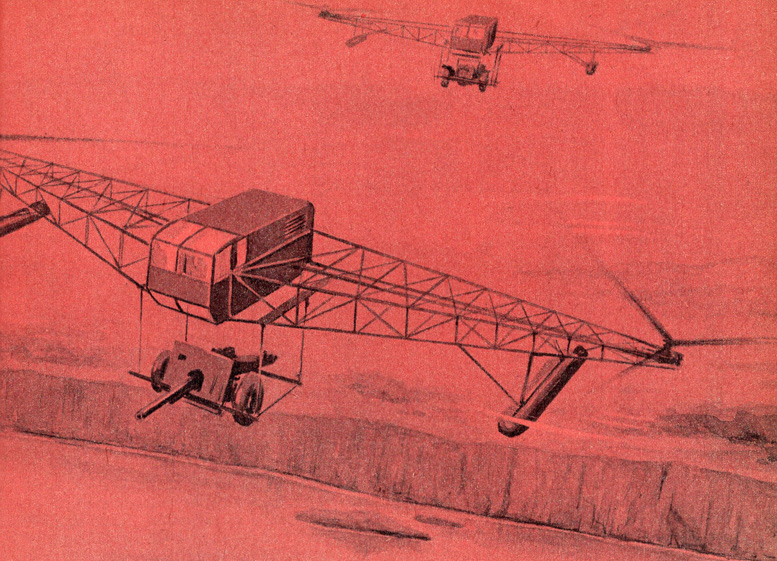
As far back as 1932, he points out, the Focke-Wulf interests in Germany had a successful machine, with two props laterally dis posed (Platt-LePage got the American rights for this model). And just recently the Germans were reported to be using an oversize type of helicopter on the Russian front as an aerial crane or flying jeep.
This ship, consisting of rotor, engine, and bare framework, functions as a self-propelled skyhook, picking up ammunition, light cannon, radio equipment, fuel, and similar loads to be transported across rivers, gorges, and other natural obstacles to free ground movement.
PV now has a similar job under design study, one that can lift eight to ten tons of pay load. This aerial lift, however, is not intended for commercial passenger service, being designed specifically as a shuttle to ferry trucks and light equipment for the armed forces. It’s nothing but a crane with rotors.
Private And Public ‘Copters

HELICOPTER designers are covering the transportation field from every angle. Above is a model of a fourteen-passenger air bus used by Greyhound Bus Lines to convince the Civil Aeronautics Board that it should be granted permission to use air buses in local air service over 49,130 miles of routes.
Raymond Loewy designed the cloud-bound bus in collaboration with Igor Sikorsky. At the right is a plywood ’copter designed for private use. This one has twin sixteen-foot rotors and a vertical stabilizer instead of an aft rotor.
Fred Landgraf, Los Angeles engineer, built this one. The tear drop design helps greatly in dispelling the clumsy, home-built look so common to many of these machines.
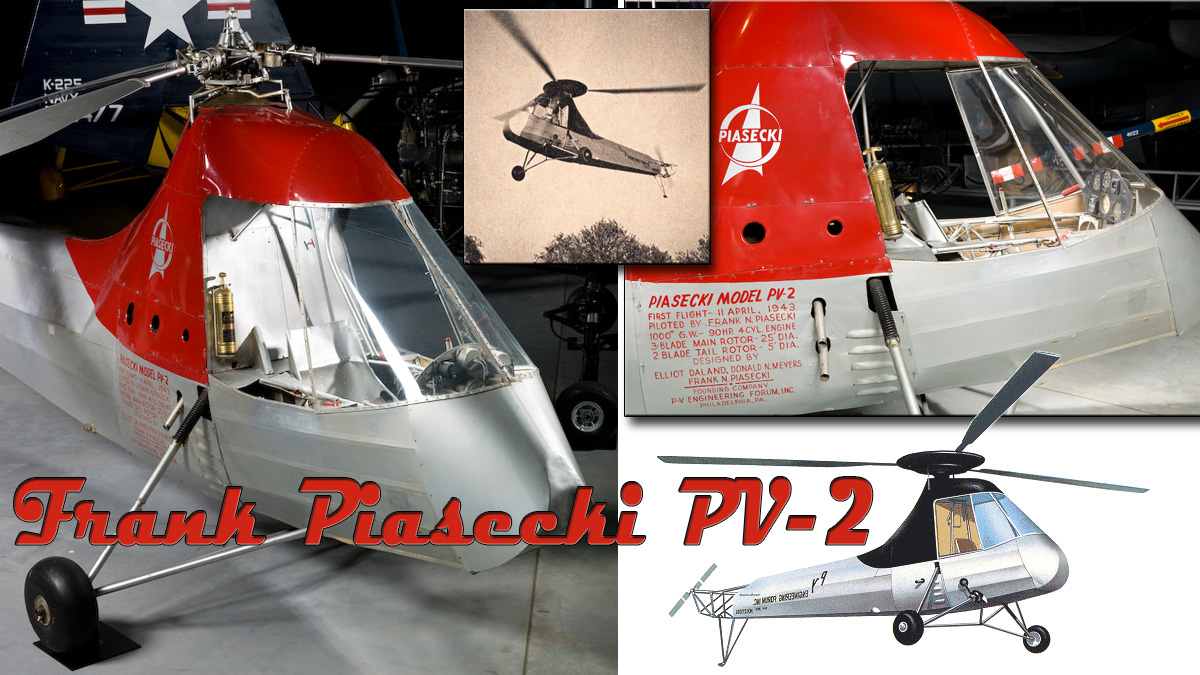

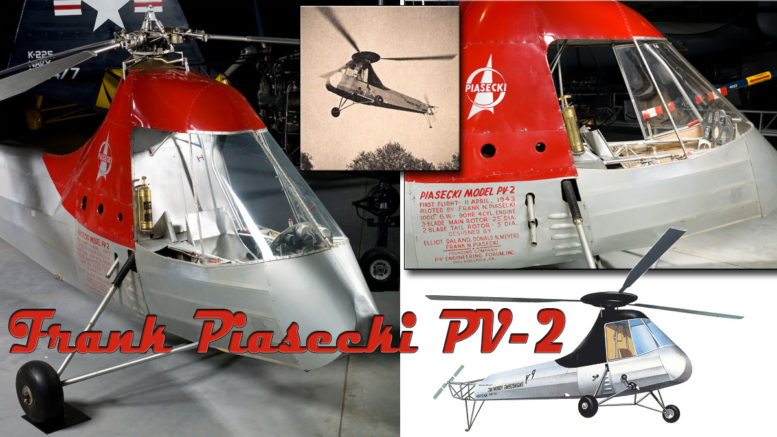
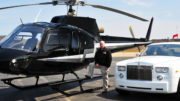
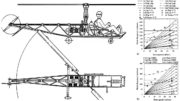
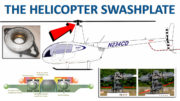
Be the first to comment on "Model T Of Helicopters"